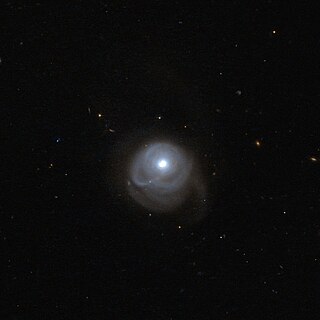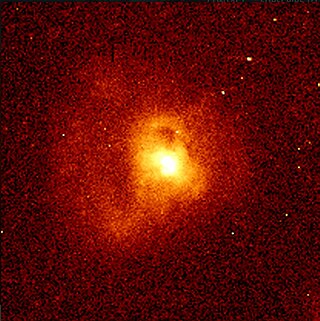Luminous infrared galaxies or LIRGs are galaxies with luminosities, the measurement of brightness, above 1011 L☉. They are also referred to as submillimeter galaxies (SMGs) through their normal method of detection. LIRGs are more abundant than starburst galaxies, Seyfert galaxies and quasi-stellar objects at comparable luminosity. Infrared galaxies emit more energy in the infrared than at all other wavelengths combined. A LIRG's luminosity is 100 billion times that of the Sun.

3C 433 is a Seyfert galaxy located in the constellation Vulpecula. It has a redshift of z =0.1016, and is classified as a peculiar radio galaxy with high luminosity other than its complex shell-type. Apart from that, it has a young stellar population and a radio structure mainly made up of knot and jet structures. Using mid-infrared wavelengths from Spitzer Observations, 3C 433 hosts a hidden quasar.

Theta Muscae is a multiple star system in the southern constellation Musca, containing a Wolf-Rayet star and two massive companions. With an apparent magnitude of 5.5, it is the second-brightest Wolf–Rayet star in the sky, although much of the visual brightness comes from the massive companions and it is not one of the closest of its type.

The Teacup galaxy, also known as the Teacup AGN or SDSS J1430+1339 is a low redshift type 2 quasar, showing an extended loop of ionized gas resembling a handle of a teacup, which was discovered by volunteers of the Galaxy Zoo project and labeled as a Voorwerpje.

Markarian 273 is a galaxy merger located in the constellation Ursa Major. It is located at a distance of about 500 million light years from Earth, which, given its apparent dimensions, means that Markarian 273 is about 130,000 light years across. It is an ultraluminous infrared galaxy and a Seyfert galaxy.

An extended emission-line region (EELR) is a giant interstellar cloud ionized by the radiation of an active galactic nucleus (AGN) inside a galaxy or photons produced by the shocks associated with the radio jets. An EELR can appear as a resolved cloud in relative nearby galaxies and as narrow emission lines in more distant galaxies.

IRAS 05189-2524 is a galaxy merger located in the constellation Lepus. It is located 603 million light-years away from the Solar System and has an approximate diameter of 75,000 light-years.

IRAS F11119+3257 or simply as F11119+3257, is a galaxy located in constellation Ursa Major. With a redshift of 0.187580, it has a light travel time distance of 2.5 billion light-years and is considered an ultraluminous infrared galaxy (ULIRG).

IRAS 09104+4109 is a galaxy located in the constellation Lynx. With a redshift of 0.440797, the light travel time for this galaxy, corresponds to 4.8 billion light-years from Earth. It is the brightest cluster galaxy in MACS J0913.7+4056 galaxy cluster and classified as a hyperluminous infrared galaxy.

IRAS 13218+0552 known as SFRS 263, is a galaxy merger located in the Virgo constellation. Its redshift is 0.202806, putting the object at 2.6 billion light-years away from Earth. It is a Seyfert galaxy and a luminous infrared galaxy.

PKS 1345+125 known as PKS 1345+12 and 4C +12.50, is an ultraluminous infrared galaxy (ULIG) with an active galactic nucleus, located in the constellation Boötes. With a redshift of 0.121740, the galaxy is located 1.7 billion light-years from Earth.

Markarian 463 known as UGC 8850, is a galaxy merger located in the constellation Boötes. It is located 706 million light years from Earth. It is classified a double nucleus Seyfert galaxy.

IRAS 19254-7245, more commonly referred as the "Superantennae", are a pair of interacting galaxies located in the constellation of Pavo. It is located 820 million light years from Earth. It is an ultraluminous infrared galaxy and a Seyfert galaxy.

ESO 286-19 known as IRAS 20551-4250, is a galaxy merger located in the constellation of Microscopium. It is located 609 million light years away from Earth. It is an ultraluminous infrared galaxy.

IRAS 10565+2448 known as IRAS F10565+2448, is a galaxy merger located in the constellation of Leo. It is located at a distance of 625 million light years from Earth. It is classified as an ultraluminous infrared galaxy with an infrared luminosity of 1.2 x 1012 LΘ. It has a star formation rate of 131.8 MΘ yr−1.

Markarian 1014 known as PG 0157+001 is a quasar located in the constellation Cetus. It is located at a distance of 2.47 billion light years from Earth and is classified as a Seyfert galaxy as well as an ultraluminous infrared galaxy (ULIRG).

ESO 148-2 known as ESO 148-IG002 and IRAS 23128-5919, is a galaxy merger located in the constellation of Tucana. It is located 642 million light years from Earth and is classified a Wolf-Rayet galaxy as well as an ultraluminous infrared galaxy.

IRAS 07598+6508 known as IRAS F07599+6508, is a quasar located in the constellation of Camelopardalis. It is located 2.37 billion light years from Earth and is classified as both an ultraluminous infrared galaxy and a Seyfert galaxy.

3C 459 known as IRAS 23140+0348, is a radio galaxy located in the constellation Pisces. It is located 2.74 billion light years from Earth and is classified as a Seyfert 2 and LINER galaxy.


















